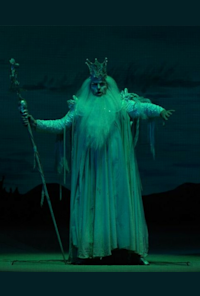“In the rich mansions of the fraternity in Novgorod. Trading merchants of Novgorod are enjoying a lively feast. All are seated at oak tables covered with patterned table cloths and laden with food and drink. Servants bring the guests wine and fire-water. Seated at a special table is Nezhata, a young gusli-player from Kiev-City. In a corner, on a tiled stove, are seated Sopel and several swashbuckling jesters. Among the guests are two regulars: Foma Nazarych and Luka Zinovich.” It is a grand feast for the fraternity, dressed in their clothes embroidered with myriad patterns and the tiled stove richly decorated. Even Rimsky-Korsakov’s own comments in his score for the opera Sadko were written in the “Old Russian style”, heavy with archaic lexis and expressions. The composer, much in love with Russia-of-old, found sources of inspiration in northern tales and legends – about the rich gusli-player and merchant Sadko, about the dashing troublemaker Vasily Buslayev and about the mighty bogatyr Volkh Vseslavich. The sonorous timbre of Rimsky-Korsakov’s guslis – following in the footsteps of Glinka – is depicted by a combination of the piano and the harp. The rhythms of this epic in verse are conveyed by complex measures – right up to and including eleventh in the chorus “The day will be beautiful in half a day’s time” (ten syllables in Russian, chanted in unison by male voices; eleven beats to one bar), which engendered the popular myth about choristers tormented by Rimsky-Korsakov’s “impossible” rhythms. In the opera there is even a “direct inclusion” of the Russian epos, recorded texts and melodies taken from living bearers of the tradition – a first in the history of the genre of opera.
And yet in addition to the epic, the opera Sadko has another side – that of the fairytale. The composer himself indicated this in a remark that determined the time-setting: “semi-fairytale and semi-historical”. As a composer and fairytale narrator, Rimsky-Korsakov knew no equal; his “magical” chords, gammas and orchestral colours sparkle and shimmer, like silver-scaled and golden-finned fish in the depths of the blue-green waters of Lake Ilmen. The protagonist is part of both worlds and associated with each of them – as the husband of two women: one real, one fairytale, one of the earth and one of the water. The love triangle in Sadko exists beyond the confines of the laws of geometry: its peaks lie on varying planes, and so the character’s bigamy escapes the laws of morality. A semi-fairytale and semi-history, Sadko nevertheless is not bereft of yet another element so important for 19th-century musical theatre – that of lyricism. In this extravagant and highly decorative score it does not appear so very much, though it is more gripping because of that – particularly when the cold sea maiden Volkhova sings her lullaby warmed by human passion “A dream walked along the shore”.
At the Mariinsky Theatre Sadko is performed using the production by Alexei Stepanyuk – featuring sets revived from sketches by Konstantin Korovin. Rimsky-Korsakov’s aesthetics were incredibly close to those of the great Russian designer. Writing of his work, the theatre decorator noted: “I wanted the eyes of the audience to have as much aesthetic pleasure as the soul’s ears received from the music. With unexpected forms and a fountain of colours I wanted to excite people’s eyes from the stage, and I saw that I was giving them something of joy and interest.” The Mariinsky Theatre invites its audiences to experience this joy. Khristina Batyushina



